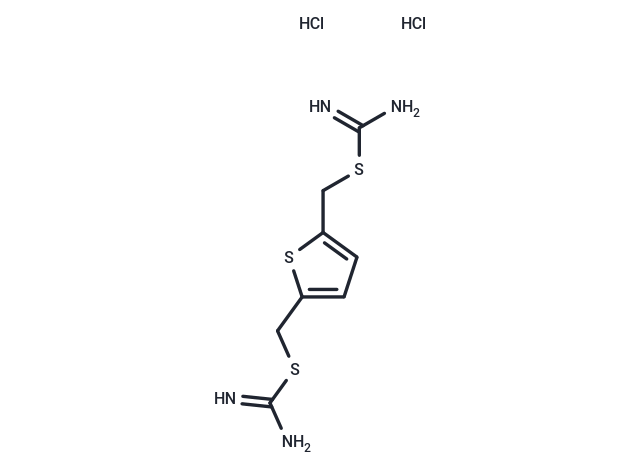Shopping Cart
- Remove All
 Your shopping cart is currently empty
Your shopping cart is currently empty

TPT-260 Dihydrochloride (NSC55712) is a thiophene thiourea derivative with molecule weight 260.00 in free base form.

| Pack Size | Price | Availability | Quantity |
|---|---|---|---|
| 2 mg | $35 | In Stock | |
| 5 mg | $55 | In Stock | |
| 10 mg | $92 | In Stock | |
| 25 mg | $176 | In Stock | |
| 50 mg | $281 | In Stock | |
| 100 mg | $412 | In Stock | |
| 200 mg | $586 | In Stock | |
| 1 mL x 10 mM (in DMSO) | $55 | In Stock |
| Description | TPT-260 Dihydrochloride (NSC55712) is a thiophene thiourea derivative with molecule weight 260.00 in free base form. |
| Kinase Assay | Lyophilized Cdc42 protein is reconstituted to 5 mg/mL in a buffer consisting of 50 mM Tris, 0.5 mM MgCl2, 50 mM NaCl, 3% (wt/vol) sucrose, and 0.6% dextran. The stock solution is then diluted to 1 μM in 5 mM phosphate buffer, pH 7.4. Into a quartz cuvettete containing Cdc42 solution, aliquots of ZCL278 are added and incubated for 5 min before each fluorescent measurement. The excitation wavelength is 275 nm, and the fluorescence of tryptophan at 350 nm is measured after each addition. The titration curve is fitted using the equimolar specific binding model in GraphPad, and the Kd is calculated[1]. |
| Alias | TPU-260 Dihydrochloride, TPT260 2HCl, NSC55712 |
| Molecular Weight | 333.32 |
| Formula | C8H14Cl2N4S3 |
| Cas No. | 2076-91-7 |
| Smiles | Cl.Cl.NC(=N)SCc1ccc(CSC(N)=N)s1 |
| Relative Density. | 1.59g/cm3 |
| Storage | Powder: -20°C for 3 years | In solvent: -80°C for 1 year | Shipping with blue ice. | |||||||||||||||||||||||||
| Solubility Information | DMSO: 9 mg/mL (27 mM), Sonication is recommended. | |||||||||||||||||||||||||
Solution Preparation Table | ||||||||||||||||||||||||||
DMSO
| ||||||||||||||||||||||||||

Copyright © 2015-2025 TargetMol Chemicals Inc. All Rights Reserved.